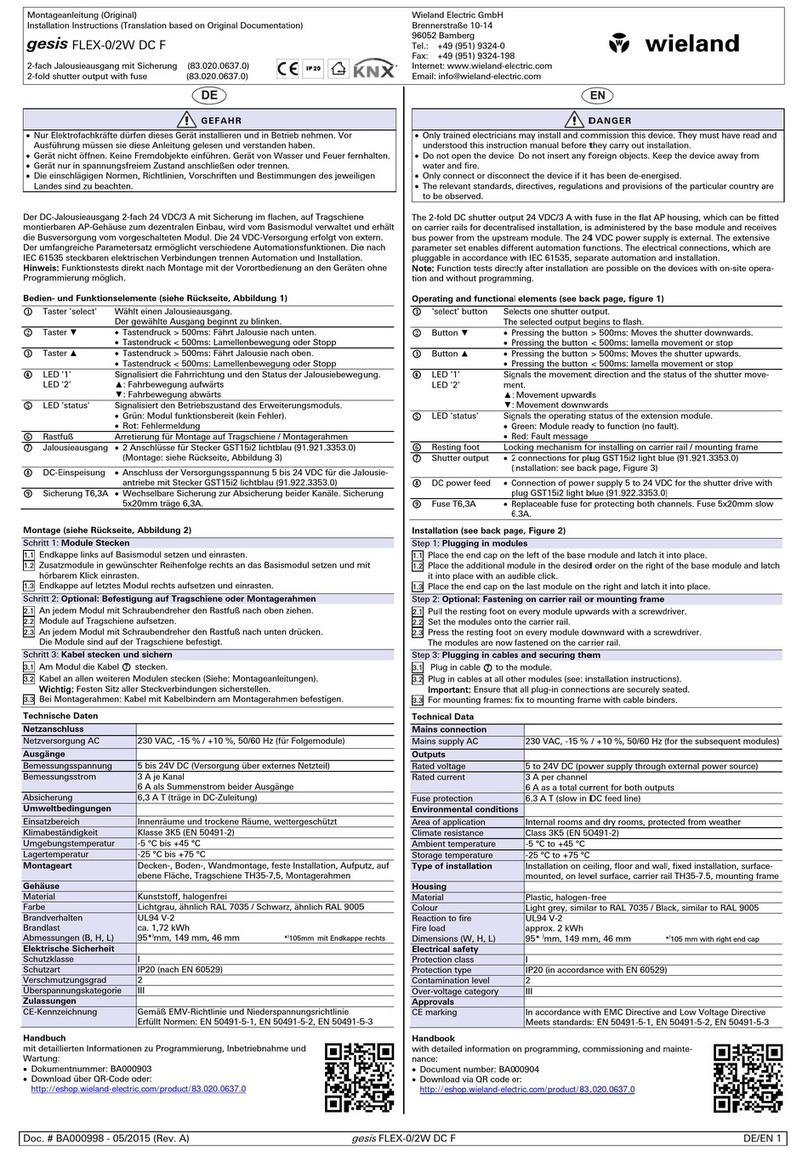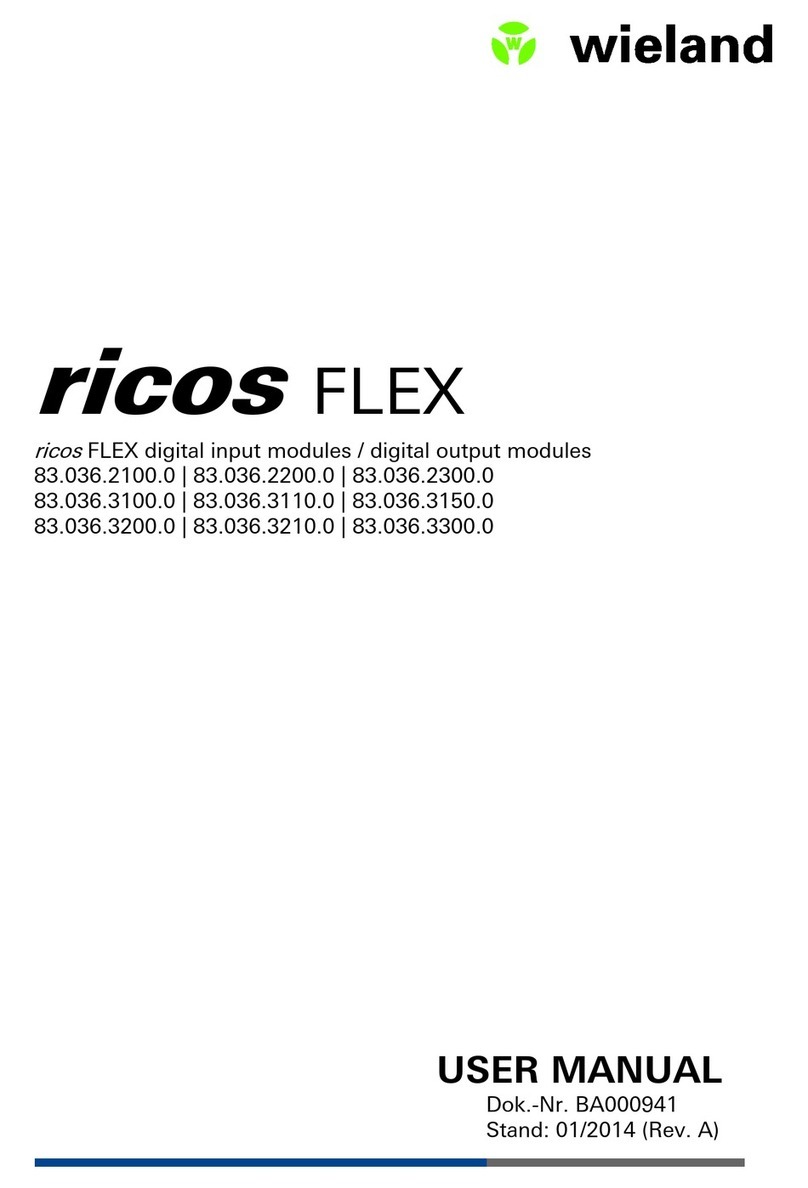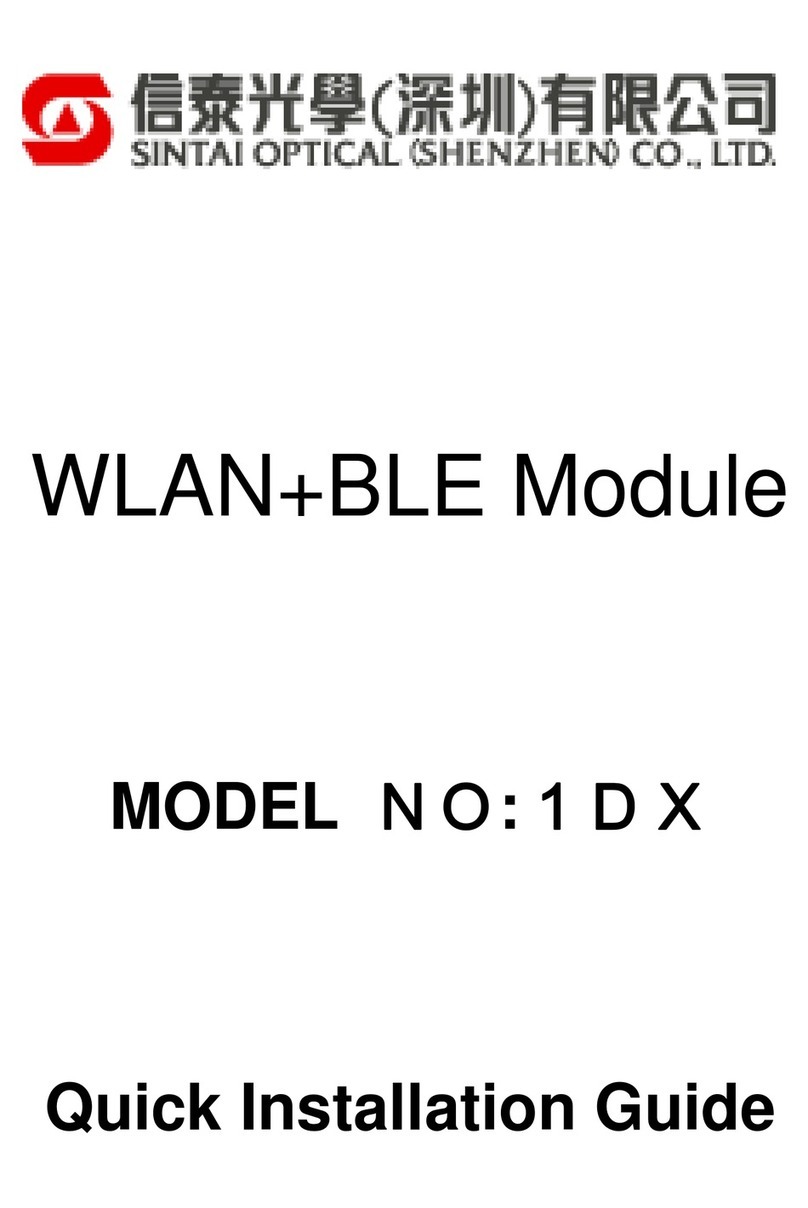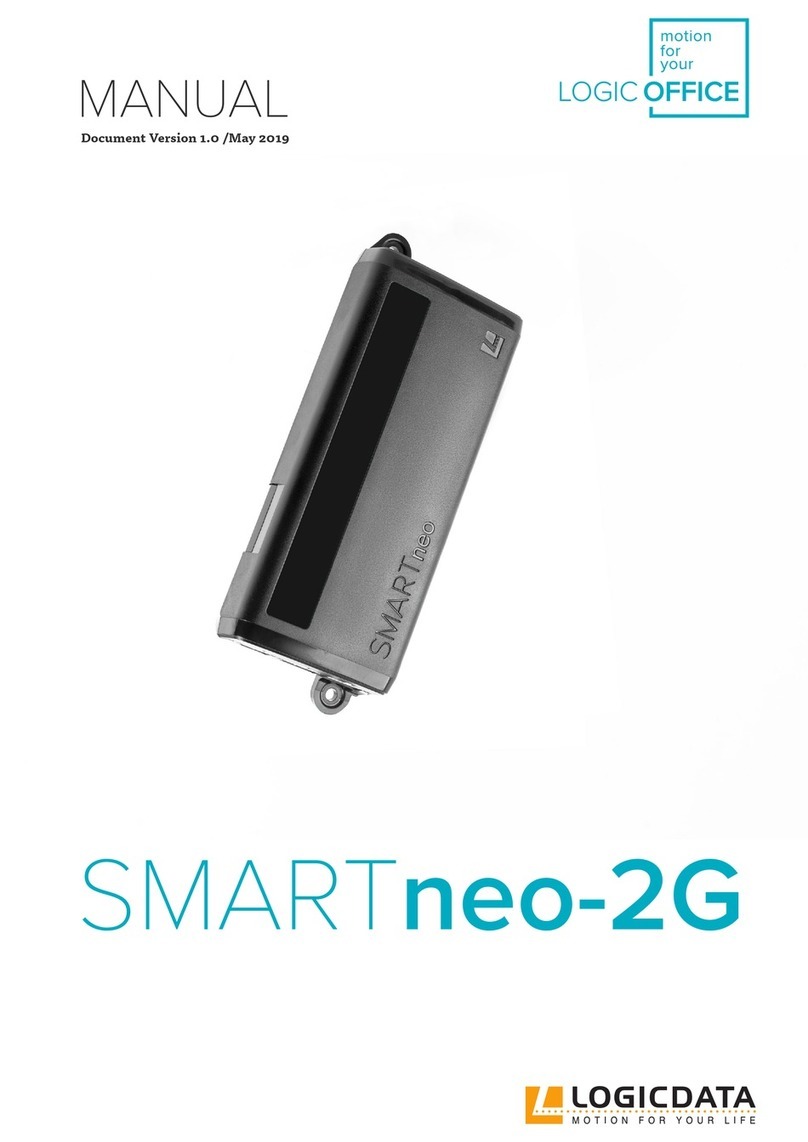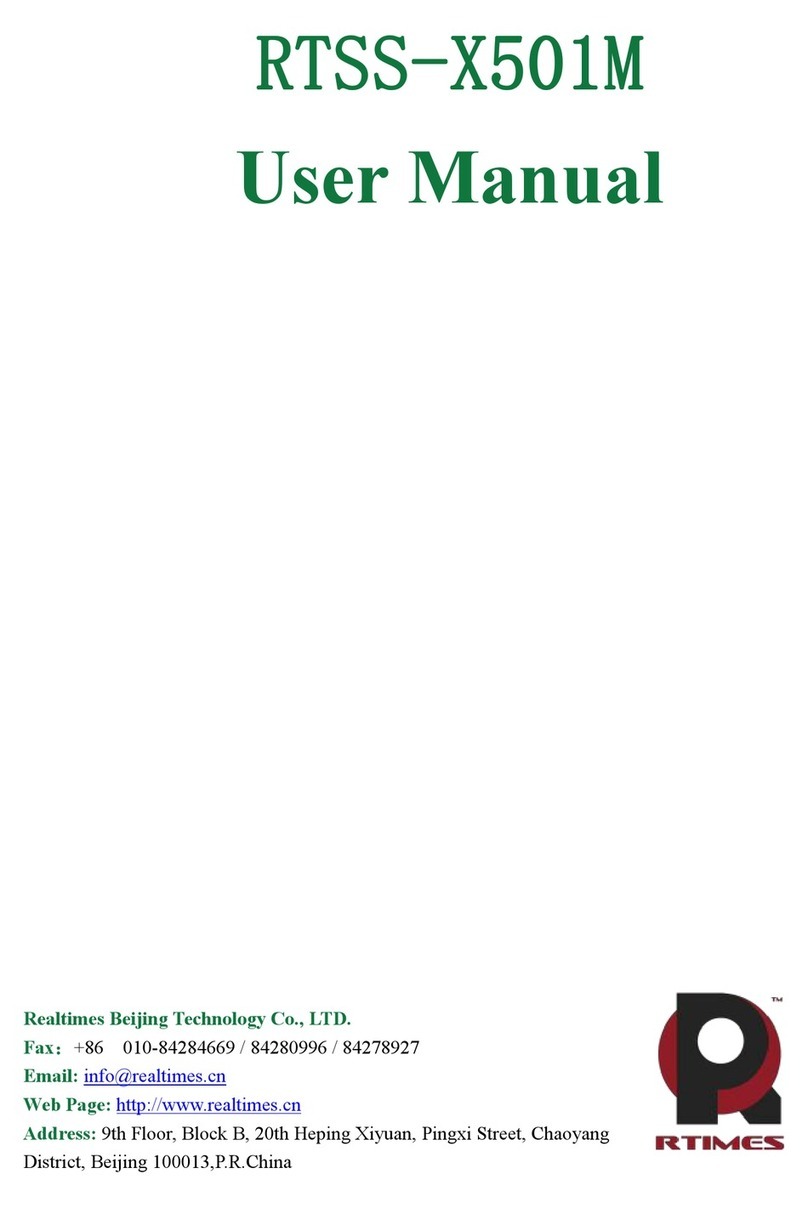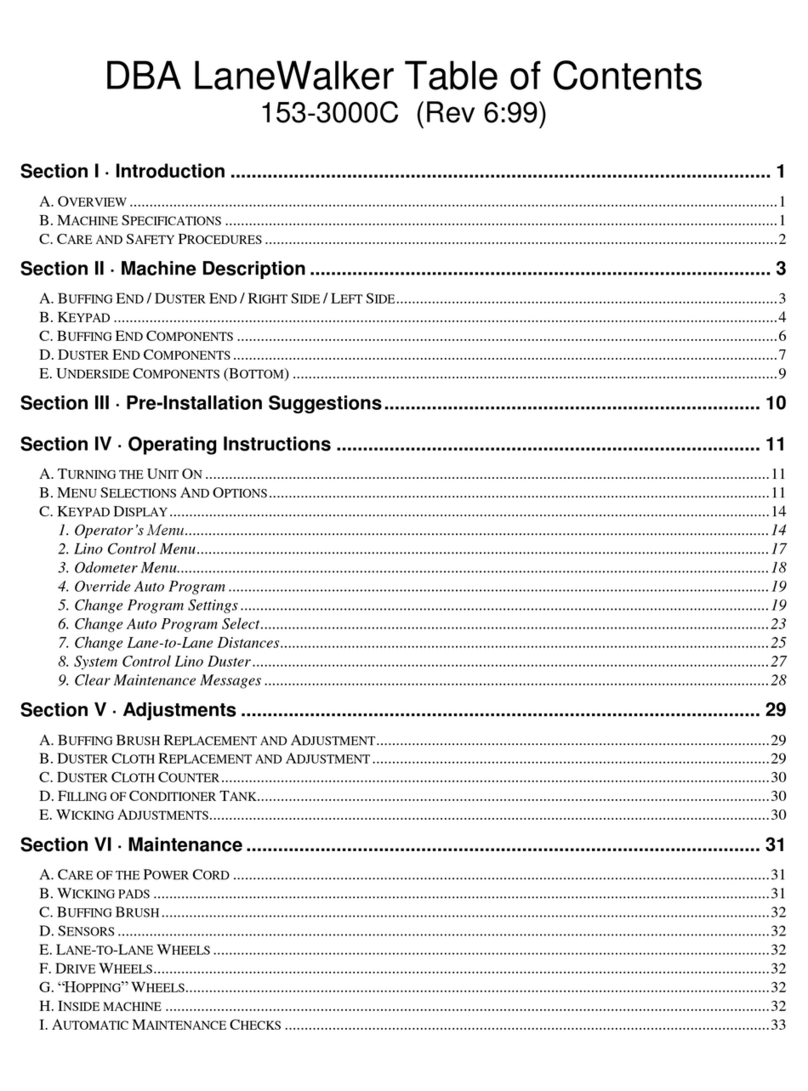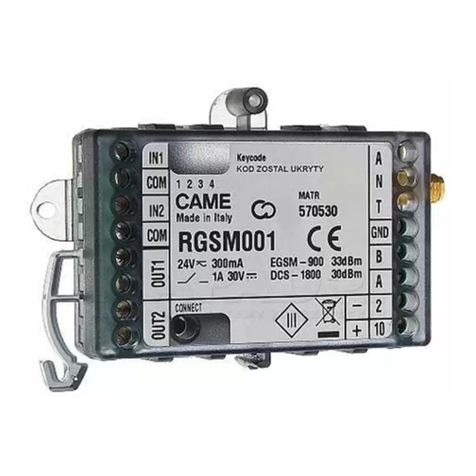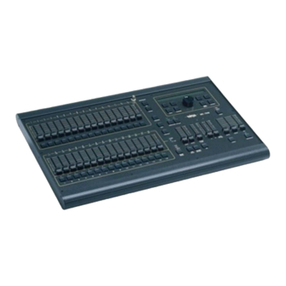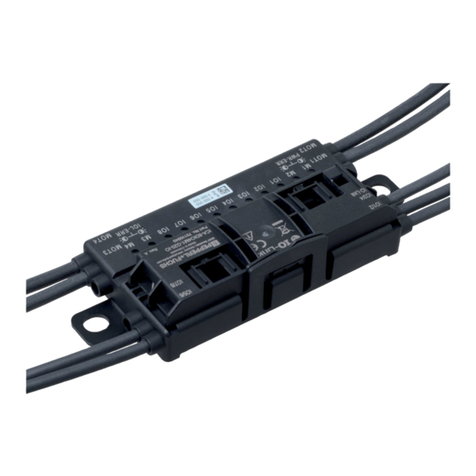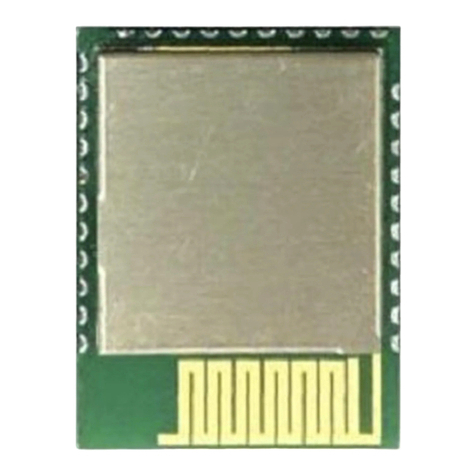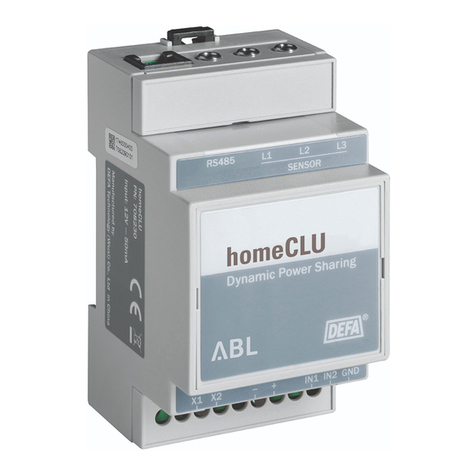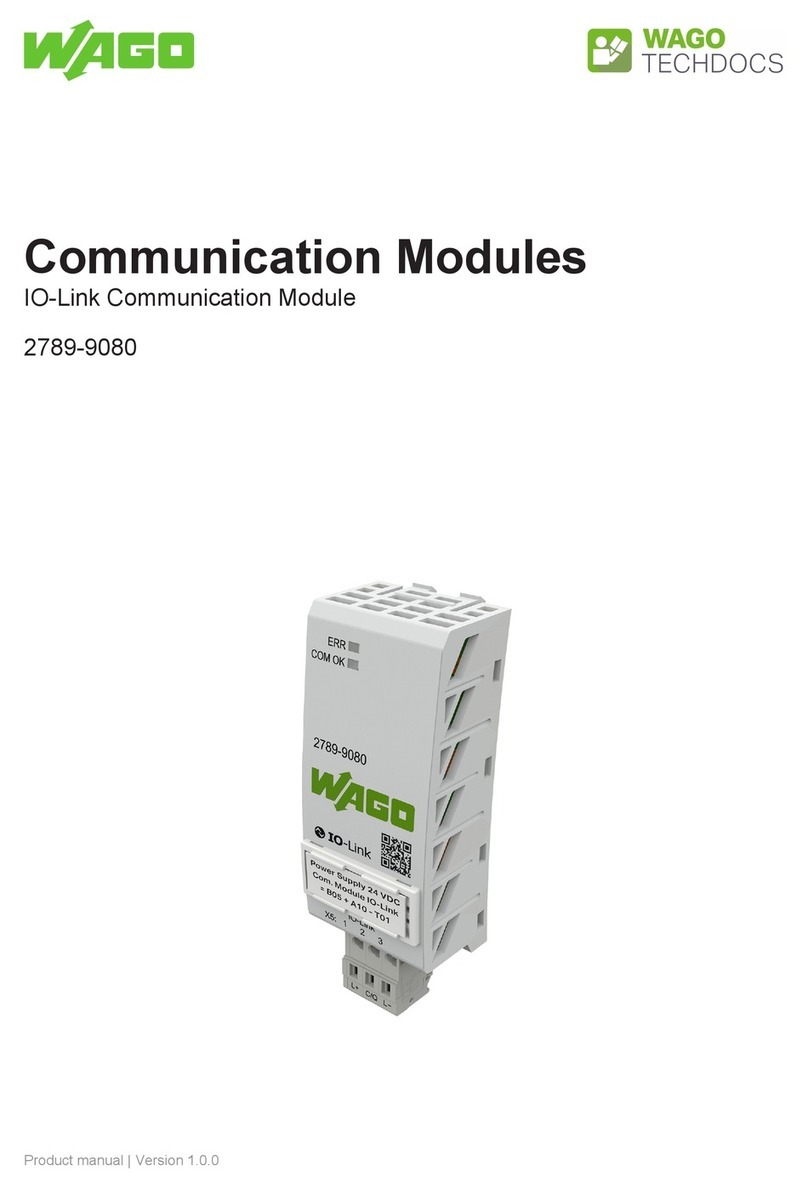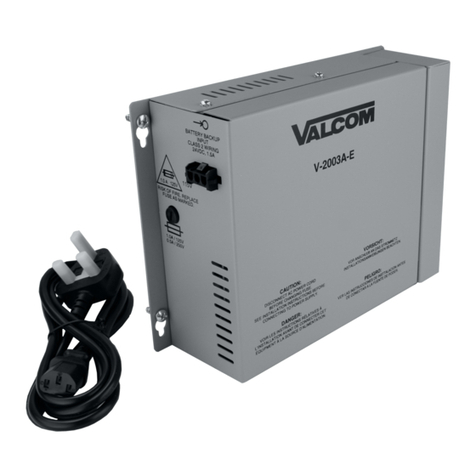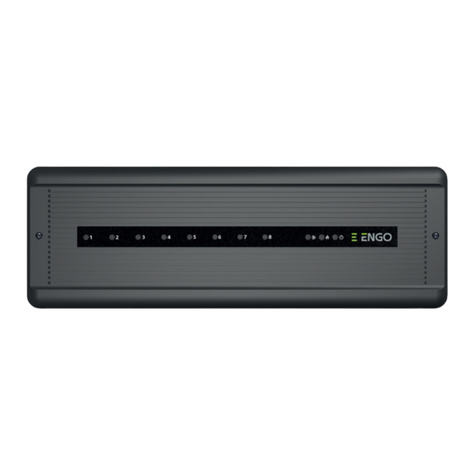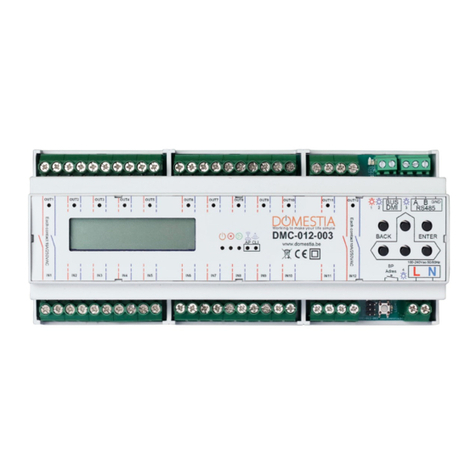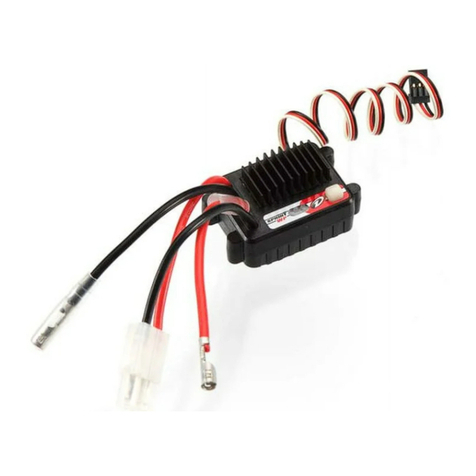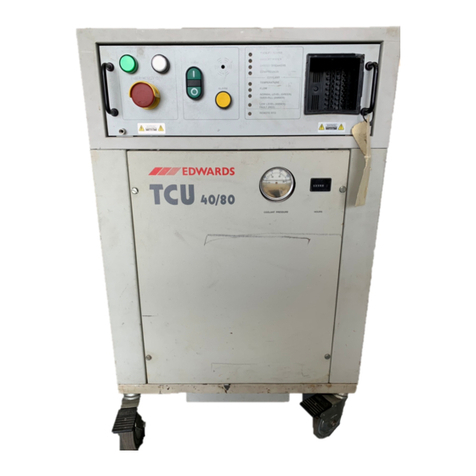Wieland GESIS FLEX-0/4 User manual

Montageanleitung (Original)
Installation Instructions (Translation based on Original Documentation)
gesis FLEX - 0/4
4-fach Schaltausgang (83.020.0623.0)
4-fold switching output (83.020.0623.0)
Wieland Electric GmbH
Brennerstraße 10-14
96052 Bamberg
Tel.: +49 (951) 9324-0
Fax: +49 (951) 9324-198
Internet: www.wieland-electric.com
Email: info@wieland-electric.com
Doc. # BA000901 - 08/2013 (Rev. A) gesis FLEX - 0/4 DE/EN 1
GEFAHR
•Nur Elektrofachkräfte dürfen dieses Gerät installieren und in Betrieb nehmen. Vor
Ausführung müssen sie diese Anleitung gelesen und verstanden haben.
•Gerät nicht öffnen. Keine Fremdobjekte einführen. Gerät von Wasser und Feuer fernhalten.
•Gerät nur in spannungsfreiem Zustand anschließen oder trennen.
•Die einschlägigen Normen, Richtlinien, Vorschriften und Bestimmungen des jeweiligen
Landes sind zu beachten.
Der Relaisausgang 4-fach 230 V/16 A im flachen, tragschienenmontierbaren AP-Gehäuse zum
dezentralen Einbau wird vom Basismodul verwaltet. Er erhält seine Netz- und Busversorgung
vom vorgeschalteten Modul. Der umfangreiche Parametersatz ermöglicht verschiedene
Automationsfunktionen. Die Handbedienebene erlaubt Funktionstests ohne vorherige Sys-
temintegration. Die nach IEC 61535 steckbaren, elektrischen Verbindungen trennen Automati-
on und Installation.
Hinweis:
Funktionstests direkt nach Montage mit der Vorortbedienung an den Geräten ohne
Programmierung möglich.
Bedien- und Funktionselemente (siehe Rückseite, Abbildung 1)
Taster 'Select'
Wählt einen Ausgang. Der gewählte Ausgang beginnt zu blinken.
Taster 'On/Off'
•Vor Parametrierung: Wechselt die Ausgangsinformation des
gewählten Ausgangs zwischen 0 und 1.
•Nach Parametrierung:
Führt die für 0 bzw. 1 hinterlegte Funktion aus.
LED
'Ausgang Status'
Signalisiert für jeden Ausgang den aktuellen Status.
•'Aktiv': LED leuchtet (nicht selektiert) oder blitzt lang auf (selek-
tiert).
•'Inaktiv': LED aus (nicht selektiert) oder blitzt kurz auf (selektiert).
LED 'Status'
Signalisiert den Betriebszustand des Erweiterungsmoduls.
•Grün: Modul funktionsbereit (kein Fehler).
•Rot: Fehlermeldung
Anschlüsse
Ausgang 1 - 4
•Stecker GST18i3
(Montage: siehe Rückseite, Abbildung 3)
Rastfuß
Arretierung für Montage auf Tragschiene/Montagerahmen
Montage (siehe Rückseite, Abbildung 2)
Schritt 1: Module Stecken
1.1 Endkappe links auf Basismodul setzen und einrasten.
1.2
Zusatzmodule in gewünschter Reihenfolge rechts an das Basismodul setzen und mit
hörbarem Klick einrasten.
1.3
Endkappe auf letztes Modul rechts aufsetzen und einrasten.
Schritt 2: Optional: Befestigung auf Tragschiene oder Montagerahmen
2.1 An jedem Modul mit Schraubendreher den Rastfuß nach oben ziehen.
2.2
Module auf Tragschiene setzen.
2.3
An jedem Modul mit Schraubendreher den Rastfuß nach unten drücken.
Die Module sind auf der Tragschiene befestigt.
Schritt 3: Kabel stecken und sichern
3.1 Am Modul die Kabel stecken.
3.2 Kabel an allen weiteren Modulen stecken (Siehe: Montageanleitungen).
Wichtig:
Festen Sitz aller Steckverbindungen sicherstellen.
3.3 Bei Montagerahmen: Kabel mit Kabelbindern am Montagerahmen befestigen.
Technische Daten
Netzanschluss
Bemessungsspannung
230 VAC, -15 % / +10 %, 50/60 Hz (GST18i3)
Bemessungsstrom max.
16 A je Ausgang und Phase (ohmsche Last)
Empfohlene Absicherung
1/3-poliger Leitungsschutzschalter B16A
Spitzeneinschaltstrom
200 A max. 50 ms (C-Last)
Umweltbedingungen
Einsatzbereich
Innenräume und trockene Räume, wettergeschützt
Klimabeständigkeit
Klasse 3K5 (EN 50491-2)
Umgebungstemperatur
-5 °C bis +45 °C
Lagertemperatur
-25 °C bis +75 °C
Montageart
Decken-, Boden-, Wandmontage, auf ebener Montagefläche
feste Installation, Aufputz, Tragschiene TH35-7,5
Gehäuse
Material
Kunststoff, halogenfrei
Farbe
Lichtgrau, ähnlich RAL 7035 / Schwarz, ähnlich RAL 9005
Brandverhalten
Brandlast
Abmessungen (B, H, L)
UL94 V-2
ca. 2,5 kWh
130*
)
mm, 149 mm, 44 mm *
)
140 mm
mit Endkappe links
Elektrische Sicherheit
Schutzklasse
I
Schutzart
IP20 (nach EN 60529)
Verschmutzungsgrad
2
Überspannungskategorie
III
Zulassungen
CE-Kennzeichnung Gemäß EMV-Richtlinie und Niederspannungsrichtlinie
Erfüllt Normen: EN 50491-5-1, EN 50491-5-2, EN 50491-5-3
Handbuch
mit detaillierten Informationen zu Programmierung, Inbetriebnahme und
Wartung:
•Dokumentnummer: BA000903
•Download über QR-Code oder:
http://eshop.wieland-electric.com/product/83.020.0623.0
DANGER
•Only trained electricians may install and commission this device. They must have read and
understood this instruction manual before they carry out installation.
•Do not open the device. Do not insert any foreign objects. Keep the device away from
water and fire.
•Only connect or disconnect the device if it has been de-energised.
•The relevant standards, directives, regulations and provisions of the particular country are
to be observed.
The 4-fold relay output 230 V/16 A in the flat AP housing, which can be fitted on DIN rails for
decentralised installation, is managed by the base module. It receives its mains supply and bus
supply from the upstream module. The extensive parameter set enables different automation
functions. The manual operation level allows function tests without prior system integration.
The electrical connections, which are pluggable in accordance with IEC 61535, separate
automation and installation.
Note:
Function tests directly after installation are possible on the devices with on-site opera-
tion and without programming
Operating and functional elements (see back page, figure 1)
'Select' button
Selects an output. The selected output begins to flash.
'On/Off' button
•Before parametrisation: Changes the output information of the
selected output between 0 and 1.
•After parametrisation:
Performs the function which is stored for 0 or 1.
LED for
'Output status'
Signals the current status for each output.
•'Active': LED lights up (not selected) or flashes with long flashes
(selected).
•'Inactive': LED off (not selected) or flashes with short flashes
(selected).
LED for 'Status'
Signals the operating status of the extension module.
•Green: Module ready to function (no fault).
•
Red: Fault message
Output connec-
tions 1 - 4
•Plug GST18i3
(installation: see back page, figure 3)
Resting foot
Locking mechanism for installing on DIN rail/mounting frame
Installation (see back page, figure 2)
Step 1: Plugging in modules
1.1
Place the end cap on the left of the base module and latch it into place.
1.2
Place additional modules in the desired sequence on the right of the base module and
latch them into place with an audible click.
1.3
Place the end cap on the last module on the right and latch it into place.
Step 2: Optional: Fastening on DIN rail or mounting frame
2.1 Pull the resting foot on every module upwards with a screwdriver.
2.2 Place the modules on the DIN rail.
2.3
Press the resting foot on every module downwards with a screwdriver.
The modules are now fastened on the DIN rail.
Step 3: Plugging in cables and securing them
3.1 Plug in cable 5 to the module.
3.2 Plug in cables to all further modules (see installation instructions).
Important:
Ensure that all plug-in connections are securely seated.
3.3 In the case of a mounting frame: Fasten cables with cable ties to the mounting frame.
Technical data
Mains connection
Rated voltage
230 VAC, -15 % / +10 %, 50/60 Hz (GST18i3)
Rated current max.
16 A each output and phase (ohmic load)
Recommended fuse protec-
tion
1/3-pin circuit breaker B16A
Peak inrush current
200 A max. 50 ms (C load)
Ambient conditions
Area of application
Internal rooms and dry rooms, protected from weather
Climate resistance
Class 3K5 (EN 50491-2)
Ambient temperature
-5 °C to +45 °C
Storage temperature
-25 °C to +75 °C
Type of installation
Installation on ceiling, floor and wall, fixed installation on level
mounting surface, surface-mounted, DIN rail TH35-7.5
Housing
Material
Plastic, halogen-free
Colour
Light grey, similar to RAL 7035 / Black, similar to RAL 9005
Reaction to fire
Fire load
Dimensions (W, H, L)
UL94 V-2
approx. 2.5 kWh
130*
)
mm, 149 mm, 44 mm *
)
140 mm with left end cap
Electrical safety
Protection class
I
Protection type
IP20 (in accordance with EN 60529)
Contamination level
2
Overvoltage category
III
Approvals
CE marking
In accordance with EMC Directive and Low Voltage Directive
Meets standards: EN 50491-5-1, EN 50491-5-2, EN 50491-5-3
Handbook
with detailed information on programming, commissioning and mainte-
nance:
•Document number: BA000904
•Download via QR code or:
http://eshop.wieland-electric.com/product/83.020.0623.0

Montageanleitung (Original)
Installation Instructions (Translation based on Original Documentation)
gesis FLEX - 0/4
4-fach Schaltausgang (83.020.0623.0)
4-fold switching output (83.020.0623.0)
Wieland Electric GmbH
Brennerstraße 10-14
96052 Bamberg
Tel.: +49 (951) 9324-0
Fax: +49 (951) 9324-198
Internet: www.wieland-electric.com
Email: info@wieland-electric.com
Doc. # BA000901 - 08/2013 (Rev. A) gesis FLEX - 0/4 DE/EN 2
Abbildung 1: Bedien- und Funktionselemente
Figure 1: Operating and functional elements
Abbildung 2: Montage
Figure 2: Installation
Abbildung 3: Montage der Stecker
Figure 3: Installation of the plugs
GST18i3
(92.932.3053.1)
Drehmoment
0,5 … 0,7 Nm
4,4 … 6,2 lb-in
Torque

Instructions de montage (Traduction de la notice originale)
Istruzioni per il montaggio (Traduzione delle istruzioni originali)
gesis FLEX - 0/4
Sortie de commutation 4 postes (83.020.0623.0)
Uscita di commutazione a 4 canali (83.020.0623.0)
Wieland Electric GmbH
Brennerstraße 10-14
96052 Bamberg
Tel.: +49 (951) 9324-0
Fax: +49 (951) 9324-198
Internet: www.wieland-electric.com
Email: info@wieland-electric.com
Doc. # BA000901 - 08/2013 (Rev. A) gesis FLEX - 0/4 FR/IT 1
DANGER
•Seuls les électriciens spécialisés sont autorisés à installer cet appareil et à le mettre en
service. Avant de commencer, ils doivent avoir lu et compris ces instructions.
•Ne pas ouvrir l'appareil. Ne pas insérer d'objets tiers. Tenir l'appareil éloigné de l'eau et du
feu.
•Ne raccorder l'appareil ou ne le déconnecter que lorsqu'il n'est pas sous tension.
•Respecter les normes, directives, prescriptions et dispositions applicables dans chaque
pays.
La sortie de relais 4 postes 230 V/16 A dans le boîtier plat en saillie pour le montage décentr.
sur rail, est gérée par le module de base. L'alim. réseau et bus de cette entrée est assurée par
le module monté en amont. Le bloc de param. compl. permet diff. fonctions d'automatisation.
Le niveau de cde manuelle permet d'effectuer des tests de fonct. sans intégration préalable au
système. Les raccords électriques enfichables selon CEI 61535 séparent l'automatisation et
l'installation.
Remarque :
la réalisation des tests de fonctionnement directement après le montage selon les
conditions du site sur les appareils est possible sans programmation.
Éléments de commande et de fonction (voir verso, figure 1)
Bouton 'Select'
Sélectionne la sortie. La sortie sélectionnée commence à clignoter.
Bouton 'On/Off'
•Avant le paramétrage :
Commute l'information de sortie de la sortie sélectionnée en 0 et 1.
•Après le paramétrage :
Exécute la fonction programmée pour 0 ou 1.
LED
'État de la sortie'
Signale l'état actuel pour chaque sortie.
•'Actif' : la LED s'allume (non sélectionnée) ou flashe longuement
(sélectionnée).
•'Inactif' : la LED s'éteint (non sélectionnée) ou flashe brièvement
(sélectionné).
LED 'État'
Signale l'état de fonctionnement du module d'extension.
•Vert : module prêt à fonctionner (pas d'erreur).
•Rouge : message d'erreur
Raccordements
des sorties 1 - 4
•Connecteur GST18i3
(Montage : voir verso, figure 3)
Pied encliquetable
Arrêt pour le montage sur rail porteur/cadre de montage
Montage (voir verso, figure 2)
Étape 1 : raccordement du module
1.1 Monter le capuchon d'extrémité sur le côté gauche du module de base et l'encliqueter.
1.2
Monter les modules supplémentaires dans l'ordre souhaité à droite du module de base et
les encliqueter jusqu'à entendre un clic.
1.3
Monter le capuchon d'extrémité sur le côté droit du dernier module et l'encliqueter.
Étape 2 : option de fixation sur rail porteur ou cadre de montage
2.1
Tirer le pied encliquetable vers le haut sur chaque module à l'aide d'un tournevis.
2.2 Placer les modules sur le rail porteur.
2.3
Pour le pied encliquetable vers le bas à l'aide d'un tournevis sur chaque module.
Les modules sont fixés sur le rail porteur.
Étape 3 : raccorder et sécuriser le câble
3.1 Raccorder le câble au module.
3.2 Raccorder le câble à tous les autres modules (voir : instructions de montage).
Important :
s'assurer de la bonne fixation de tous les raccords enfichés.
3.3 Avec cadre de montage : fixer les câbles sur le cadre de montage à l'aide de serre-câbles.
Caractéristiques techniques
Raccordement secteur
Tension nominale
230 VCA, -15 % / +10 %, 50/60 Hz (GST18i3)
Intensité nominale max.
16 A par sortie et phase (sans charge ohmique)
Fusible recommandé
Disjoncteur 1/3 pôles B16A
Courant d'enclenchement
de pointe
200 A max. 50 ms (charge C)
Conditions ambiantes
Zones d'utilisation
Espaces intérieurs et locaux secs, protégés contre les intempéries
Résistance à l'environne-
ment
Classe 3K5 (EN 50491-2)
Température ambiante
de -5 °C à +45 °C
Température de stockage
de -25 °C à +75 °C
Type de montage
Montage au plafond, au sol, au mur, sur surface de montage
plane ; installation fixe, en saillie, rail porteur TH35-7,5
Boîtier
Matériau
Matière plastique, sans halogène
Couleur
gris clair, similaire à RAL 7035 / noir, similaire à RAL 9005
Comportement au feu
Charge d'incendie
Dimensions (l, H, L)
UL94 V-2
env. 2,5 kWh
130*
)
mm, 149 mm, 44 mm *
)
140 mm
avec capuchon d'extrémité
Sécurité électrique
Classe de protection
I
Indice de protection
IP20 (selon EN 60529)
Degré d'encrassement
2
Catégorie de surtension
III
Homologations
Marquage CE
Conformément à la directive CEM et Basse tension
Conforme aux normes : EN 50491-5-1, EN 50491-5-2,
EN 50491-5-3
Notice
comprenant des informations détaillées sur la programmation, mise en
service et maintenance :
•Numéro de document : BA000904
•Téléchargement via code QR ou :
http://eshop.wieland-electric.com/product/83.020.0623.0
PERICOLO
•L'installazione e la messa in servizio di questo apparecchio devono essere eseguiti
esclusivamente da elettrotecnici che devono aver letto e compreso le presenti istruzioni
prima di effettuare qualsiasi operazione.
•Non aprire l'apparecchio. Non introdurre oggetti estranei. Mantenere l'apparecchio lontano
da acqua e fuoco.
•Collegare o scollegare l'apparecchio solo in assenza di tensione.
•Rispettare le norme, direttive, prescrizioni e disposizioni in vigore nel paese di impiego.
L'uscita relè a 4 canali 230 V/16 A in custodia piatta da parete su guida di supporto per instal-
lazione decentrata è gestita dal modulo base. L'alimentazione di rete e bus proviene dal
modulo inserito a monte. L'ampia gamma di parametri impostabili consente di realizzare
diverse funzioni di automazione. Il comando manuale permette di testare le funzioni senza
dover integrare il sistema. I collegamenti elettrici a innesto a norma IEC 61535 separano
automazione e installazione.
Nota:
è possibile eseguire la verifica delle funzioni subito dopo l'installazione con il comando
locale presente sugli apparecchi, senza alcuna programmazione.
Elementi di comando e funzionali (vedere a tergo la figura 1)
Tasto 'Seleziona'
Consente di selezionare un'uscita. L'uscita selezionata inizia a
lampeggiare.
Tasto 'On/Off'
•Prima della parametrizzazione: serve per commutare le informazio-
ni di uscita dell'uscita selezionata tra 0 e 1.
•Dopo la parametrizzazione:
esegue la funzione abbinata a 0 o 1.
LED
'Stato uscita'
Segnala lo stato corrente di ogni uscita.
•'Attiva': LED acceso (non selezionato) oppure emette lampeggi
lunghi (selezionato).
•'Inattiva': LED spento (non selezionato) oppure emette lampeggi
brevi (selezionato).
LED 'Stato'
Segnala le condizioni di esercizio del modulo di espansione.
•Verde: modulo pronto per l'uso (nessun errore).
•Rosso: segnalazione di errore
Collegamenti
uscita 1 - 4
•Connettore GST18i3
(montaggio: vedere dietro, figura 3)
Piedino di fissag-
gio
Dispositivo di fissaggio per l'installazione su guida di supporto/telaio
di montaggio
Montaggio (vedere dietro, figura 2)
Passo 1: inserimento dei moduli
1.1
Inserire il cappuccio terminale a sinistra sul modulo base.
1.2
Inserire gli altri moduli nella sequenza desiderata a destra del modulo base, fino ad
avvertire il "clic" che indica l'avvenuto bloccaggio.
1.3 Applicare il cappuccio terminale sull'ultimo modulo a destra.
Passo 2: opzionale: fissaggio su guida di supporto o telaio di montaggio
2.1 Su ogni modulo spostare il piedino di fissaggio verso l'alto con un cacciavite.
2.2 Posizionare i moduli sulla guida di supporto.
2.3
Su ogni modulo premere il piedino di fissaggio verso il basso con un cacciavite.
I moduli sono ora fissati alla guida di supporto.
Punto 3: inserimento e fissaggio dei cavi
3.1 Inserire il cavo sul modulo.
3.2 Inserire i cavi in tutti gli altri moduli (vedere le istruzioni di montaggio).
Importante:
assicurarsi che tutti i connettori siano saldamente fissati.
3.3 In caso di montaggio su telaio: fissare i cavi al telaio con fascette fermacavi.
Dati tecnici
Collegamento di rete
Tensione nominale
230 VAC, -15 % / +10 %, 50/60 Hz (GST18i3)
Corrente nominale max.
16 A per uscita e fase (carico ohmico)
Protezione consigliata
Interruttore magnetotermico 1/3 fase B16A
Corrente di picco all'inser-
zione
200 A max. 50 ms (carico C)
Condizioni ambientali
Campo d'impiego
In ambienti interni, asciutti e protetti dagli agenti atmosferici
Resistenza ai fattori climati-
ci
Classe 3K5 (EN 50491-2)
Temperatura ambiente
-5 °C ... +45 °C
Temperatura di stoccaggio
-25 °C ... +75 °C
Tipo di montaggio
A soffitto, pavimento, parete, installazione fissa su superficie
piana, a vista, su guida di supporto TH35-7,5
Custodia
Materiale
PVC, senza alogenati
Colore
Grigio chiaro, simile a RAL 7035 / Nero, simile a RAL 9005
Resistenza al fuoco
Carico comburente
Dimensioni (LxHxL)
UL94 V-2
ca. 2,5 kWh
130*
)
mm, 149 mm, 44 mm *
)
140 mm
con cappuccio terminale
Sicurezza elettrica
Classe di protezione
I
Grado di protezione
IP20 (secondo EN 60529)
Grado d'inquinamento
2
Categoria di sovratensione
III
Omologazioni
Marchio CE
Secondo la Direttiva EMC e la Direttiva bassa tensione
Conforme alle norme: EN 50491-5-1, EN 50491-5-2,
EN 50491-5-3
Manuale
con informazioni dettagliate sulla programmazione, messa in servizio e
manutenzione:
•Documento numero: BA000904
•Download mediante codice QR o:
http://eshop.wieland-electric.com/product/83.020.0623.0

Instructions de montage (Traduction de la notice originale)
Istruzioni per il montaggio (Traduzione delle istruzioni originali)
gesis FLEX - 0/4
Sortie de commutation 4 postes (83.020.0623.0)
Uscita di commutazione a 4 canali (83.020.0623.0)
Wieland Electric GmbH
Brennerstraße 10-14
96052 Bamberg
Tel.: +49 (951) 9324-0
Fax: +49 (951) 9324-198
Internet: www.wieland-electric.com
Email: info@wieland-electric.com
Doc. # BA000901 - 08/2013 (Rev. A) gesis FLEX - 0/4 FR/IT 2
Figure 1: Éléments de commande et de fonction
Figura 1: Elementi di comando e funzionali
Figure 2: Montage
Figura 2: Montaggio
Figure 3: Montage des connecteurs
Figura 3: Montaggio dei connettori
GST18i3
(92.932.3053.1)
Couple
0,5 … 0,7 Nm
4,4 … 6,2 lb-in
Coppia di
serraggio
This manual suits for next models
1
Other Wieland Control Unit manuals

Wieland
Wieland gesis FLEX-8/0 (12) User manual
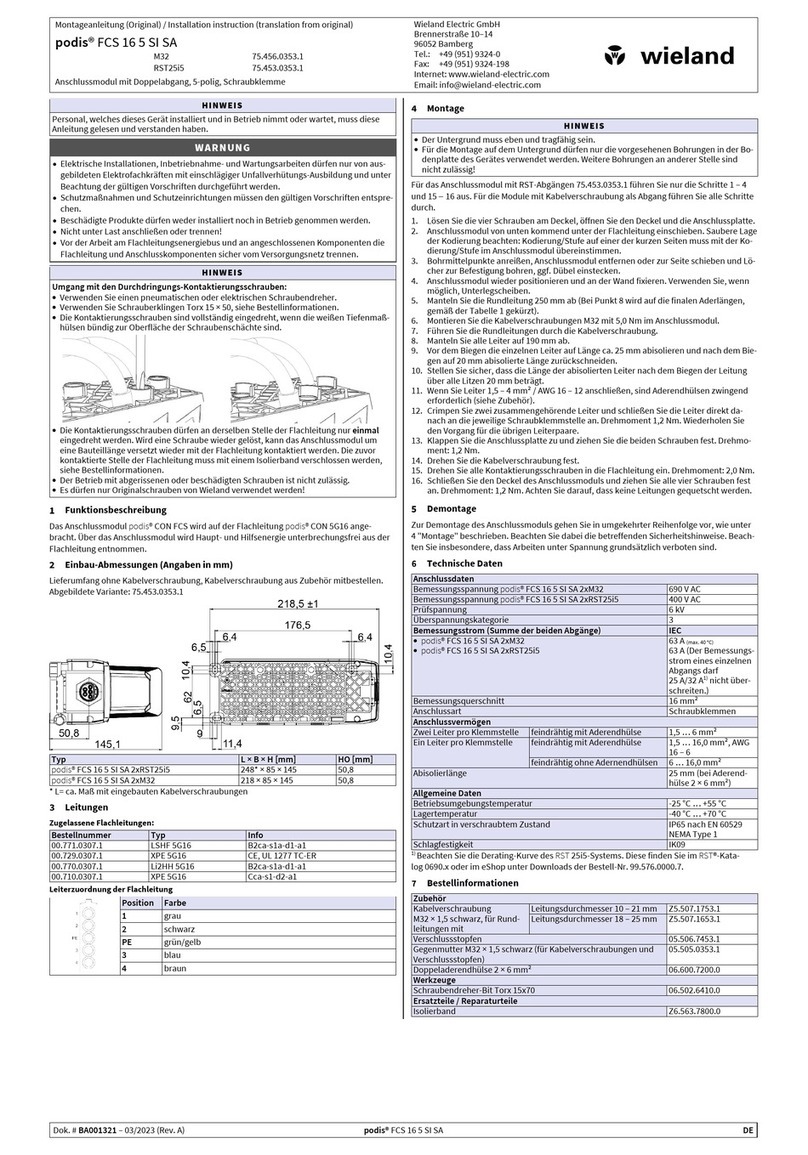
Wieland
Wieland podis FCS 16 5 SI SA User manual
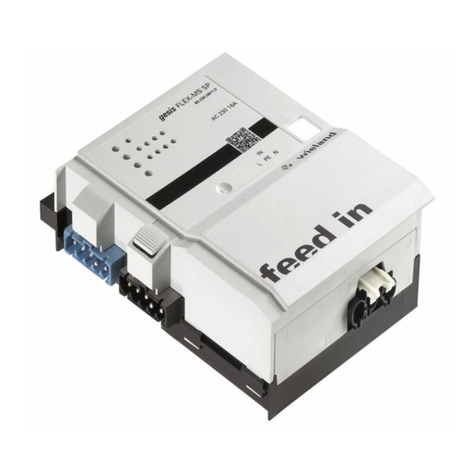
Wieland
Wieland gesis FLEX-MS User manual
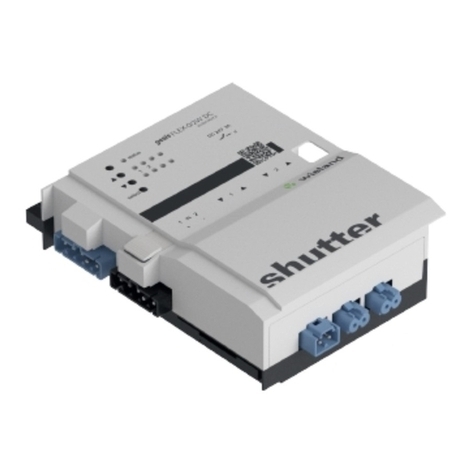
Wieland
Wieland GESIS FLEX-0/2W DC User manual

Wieland
Wieland SP-COP1 User manual

Wieland
Wieland gesis RM Series User manual
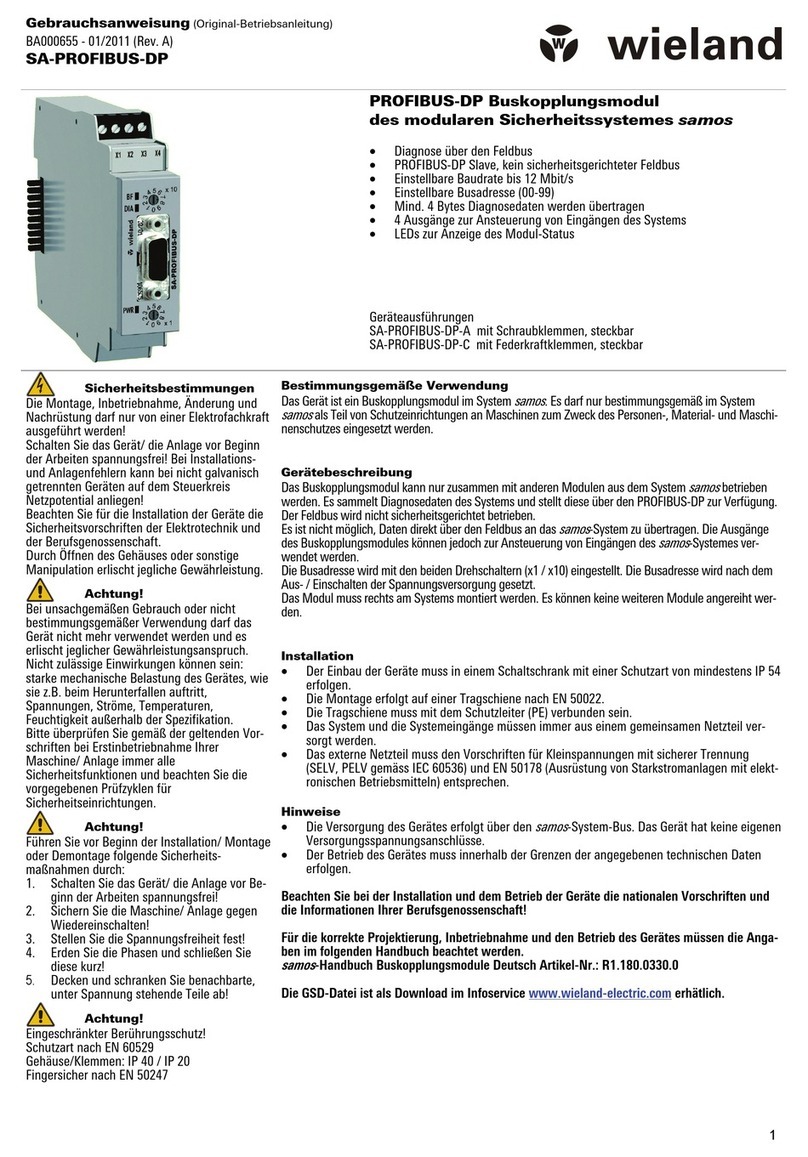
Wieland
Wieland PROFIBUS-DP Series User manual
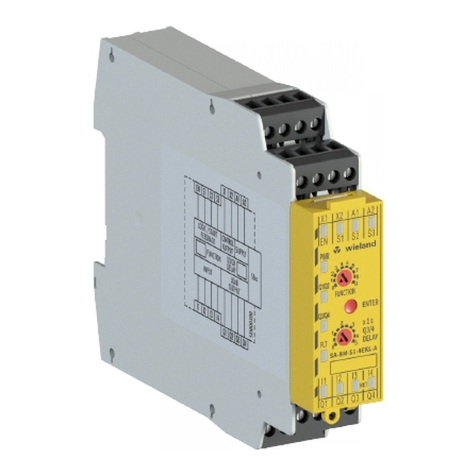
Wieland
Wieland SA-BM-S1-4EKL-A User manual
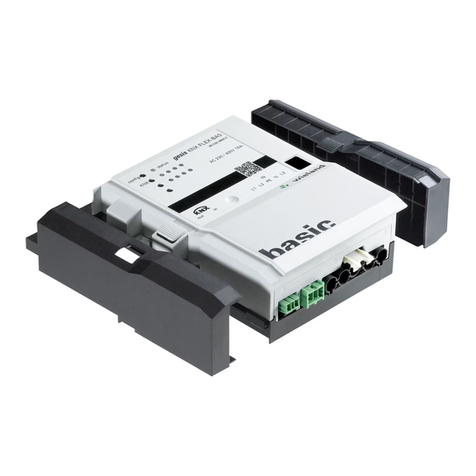
Wieland
Wieland gesis KNX FLEX-BAS User manual
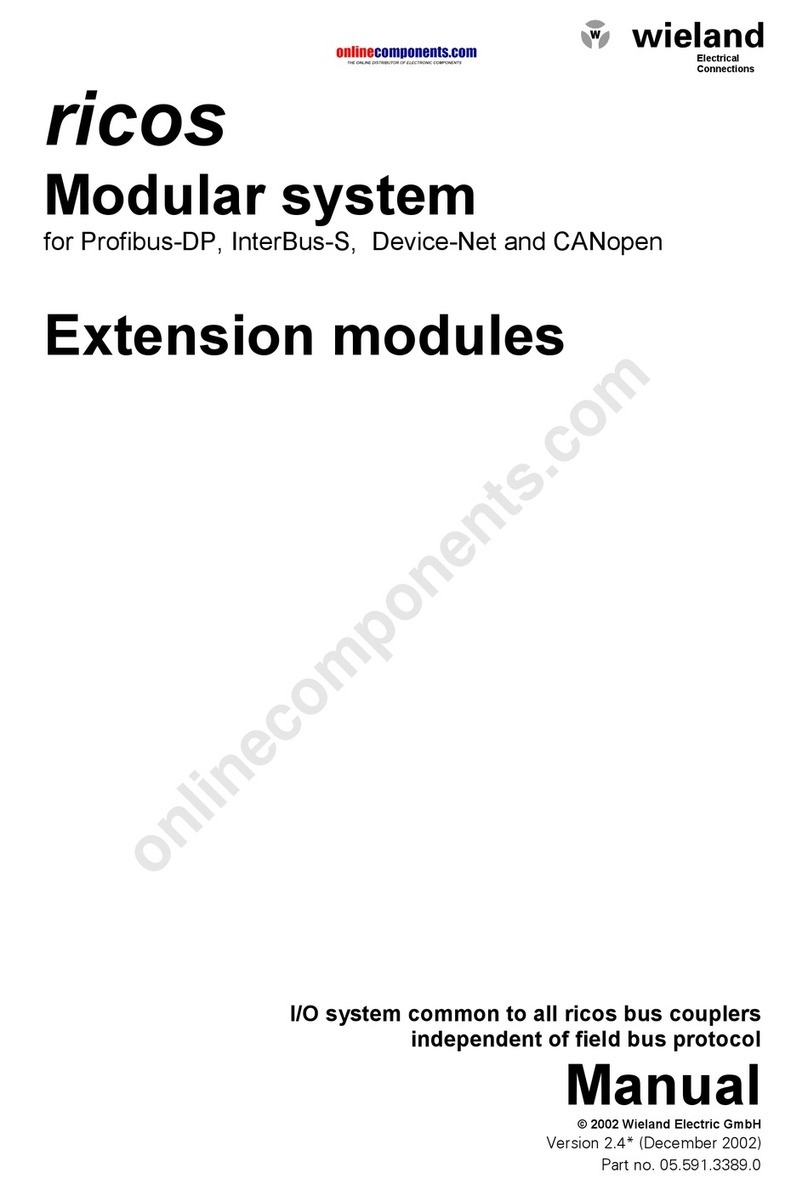
Wieland
Wieland ricos User manual
